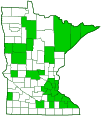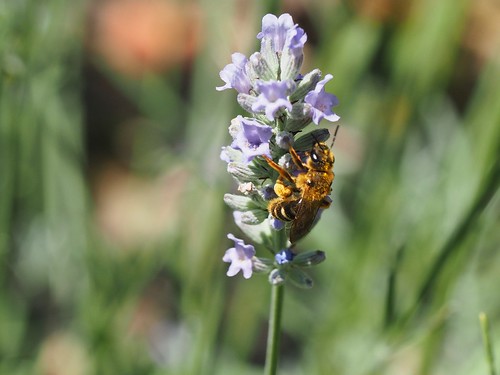orange-legged furrow bee
(Halictus rubicundus)
Conservation • Description • Habitat • Ecology • Distribution • Taxonomy
|
|
||||||||||||||
Description |
Orange-legged furrow bee is an exotic, medium-sized, common, and very widespread bee. It is a stretch to call this species exotic. It is native to Europe and Asia. It was probably introduced into North America between 26,000 and 19,000 years ago when there was a land bridge between what are now Russia and Alaska. It now occurs throughout the temperate areas of the Northern Hemisphere. In North America it has been recorded in every state and province except Nunavut. The female is ⅜″ to 7⁄16″ (10 to 11 mm) in length. The head and body are entirely black with whitish hairs and without a metallic greenish cast. The head is somewhat wider than long. The top of the head is deeply and distinctly pitted (punctured). There are two large compound eyes and between them on top of the head there are three small simple eyes (ocelli). The compound eyes converge slightly toward the bottom. The ocelli are arranged in a triangle. The lateral two ocelli are much closer to the hind margin of the head than to the compound eyes. On the face there is just a single line-like groove extending downward from the base of each antenna (subantennal suture). The cheeks (genae) are slightly wider than the eyes. The tongue is short. The thorax is deeply and distinctly punctured. The pronotum is short and collar-like. It has a rounded lobe on each side that does not reach the plates covering the wing bases (tegulae). The tegulae are brownish-black and have a narrow translucent rim on the front margin. The abdomen is minutely and very closely punctured. The punctures on the first abdominal segment are deep and distinct, and they gradually become obscure toward the end of the abdomen. There is a well-defined band of dense white hairs at the rear margin of each segment. On segments one and two the bands are narrowed in the middle. The legs are mostly black and are covered with yellowish hairs. The fourth leg segment (tibia) has long pollen-collecting hairs (scopa). The last part of each leg (tarsus), corresponding to the foot, has five segments. The last tarsal segments are rusty orange. This is the feature that gives the bee both its common name and its species epithet. The wings are mostly translucent with pale reddish-brown veins. The cell (stigma) on the leading edge (costal margin) just before the marginal cell is also pale reddish-brown. The marginal cell is pointed but not sharply pointed. There are three submarginal cells. The first cell is longer than the third. The veins dividing the submarginal cells are dark and prominent. The basal vein is strongly arced at the base, like the letter J. The male is similar in size and appearance, but the upper lip (labrum), most of the facial plate (clypeus), and the tibia and tarsus of each leg are yellow, and it has no pollen-collecting hairs. The wings are clear but slightly tinged with brown toward the tip. |
Size |
Female: ⅜″ to 7⁄16″ (10 to 11 mm) Male: ⅜″ to 7⁄16″ (10 to 11 mm) |
Similar Species |
Habitat |
|
Ecology |
Season |
March to September |
Behavior |
Northern bees tend to be more solitary and southern bees tend to be more social. Minnesota is in the intermediate zone, where both solitary and social behavior can be seen in different nests. |
Life Cycle |
|
Larva Food |
Flower pollen |
Adult Food |
Flower nectar and pollen |
Distribution |
||
|
Sources |
|
| 5/24/2025 | ||
Occurrence |
||
Common and very widespread |
||
Taxonomy |
|
Order |
Hymenoptera (ants, bees, wasps, and sawflies) |
Suborder |
Apocrita (narrow-waisted wasps, ants, and bees) |
Infraorder |
Aculeata (ants, bees, and stinging wasps) |
Superfamily |
Apoidea (bees and apoid wasps) |
Epifamily |
|
Family |
Halictidae (sweat bees) |
Subfamily |
|
Tribe |
Halictini |
Genus |
Halictus (furrow bees) |
Subgenus |
Protohalictus |
Subordinate Taxa |
|
|
|
Synonyms |
|
Apis rubicunda Halictus nesiotis Halictus nidulans Halictus quadrifasciatus |
|
Common Names |
|
orange-legged furrow bee polymorphic sweat bee |
|
Glossary
Clypeus
On insects, a hardened plate on the face above the upper lip (labrum).
Costal margin
The leading edge of the forewing of insects.
Gena
In insects: The area between the compound eye and the mandible; the cheek. In birds: The area between the the angle of the jaw and the bill; the feathered side (outside) of the under mandible. Plural: genae.
Labrum
The upper part of the mouth, sometimes considered the lower part of the face, corresponding to the upper lip, on an insect or crustacean.
Ocellus
Simple eye; an eye with a single lens. Plural: ocelli.
Scopa
A brush-like tuft of hairs on the legs or underside of the abdomen of a bee used to collect pollen.
Stigma
In plants, the portion of the female part of the flower that is receptive to pollen. In Lepidoptera, an area of specialized scent scales on the forewing of some skippers, hairstreaks, and moths. In other insects, a thickened, dark, or opaque cell on the leading edge of the wing
Tarsus
On insects, the last two to five subdivisions of the leg, attached to the tibia; the foot. On spiders, the last segment of the leg. Plural: tarsi.
Tegula
A small, hardened, plate, scale, or flap-like structure that overlaps the base of the forewing of insects in the orders Lepidoptera, Hymenoptera, Diptera, and Homoptera. Plural: tegulae.
Tibia
The fourth segment of an insect leg, after the femur and before the tarsus (foot). The fifth segment of a spider leg or palp. Plural: tibiae.
Visitor Photos |
||
Share your photo of this insect. |
||
This button not working for you? |
||
Dan W. Andree |
 |
Small black & white bee on prairie flower and.... This little bee was on a prairie violet at Frenchman’s Bluff SNA 5-22-25 … |
Alfredo Colon |
||
 |
 |
|
 |
 |
|
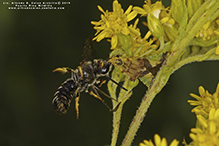 |
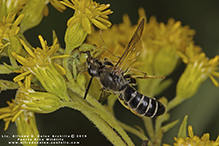 |
|
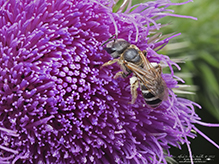 |
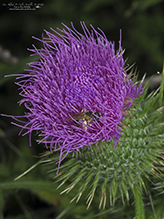 |
|
MinnesotaSeasons.com Photos |
||
|
||
|
||

Visitor Videos |
||
Share your video of this insect. |
||
This button not working for you? |
||
|
Other Videos |
||
solitary bee Halictus rubicundus investigating nest sites |
About
Apr 10, 2015 A short and rather wobbly video of the bee Halictus rubicundus. Filmed at Preston Montford Field Studies Centre, on an area of sandy bank at the edge of a pond. |
Halictus rubicundus |
About
May 7, 2018 |
Halictus rubicundus in Lady Dixon Park 20/04/2019 video 1 |
About
Apr 22, 2019 |

Visitor Sightings |
||
Report a sighting of this insect. |
||
This button not working for you? |
||
Dan W. Andree |
Location: Frenchman’s Bluff SNA This little bee was on a prairie violet at Frenchman’s Bluff SNA 5-22-25 … |
 |
| Alfredo Colon 6/11/2024 |
Location: Albany, NY |
 |
| Alfredo Colon 6/10/2024 |
Location: Albany, NY |
 |
| Alfredo Colon 8/2/2022 |
Location: Albany, NY |
 |
| Alfredo Colon 8/14/2019 |
Location: Woodbury, MN |
 |
MinnesotaSeasons.com Sightings |
||
|

Created: 2/1/2023 Last Updated: © MinnesotaSeasons.com. All rights reserved. |
